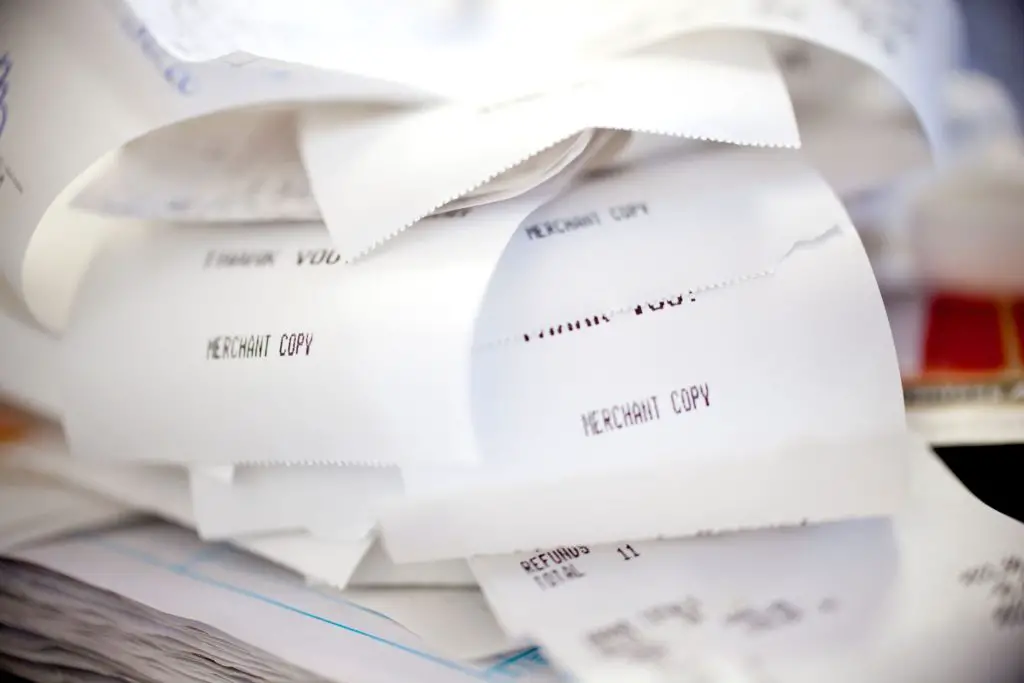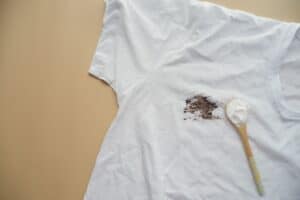How to organise receipts easily
- and dispose of them correctly!

So how to organise receipts? Well, my method is very similar to the process I use for organising paperwork – I let receipts accumulate in a designated area and when the area gets near to being full, only then do I take the time out to sort out what I need to keep and what I can discard. For those that I decide to keep, I scan them electronically and then dispose of them responsibly. It’s a super simple process I go through every 3 months or so – to keep on top of something that could easily become out of hand.
I have only started scanning receipts, but it’s something I’ve been meaning to do for a while as there are good reasons to adopt this practice. I get into the reasons further below.
So in this blog post, I’ll address these questions:
Why is it important to keep receipts organised and go electronic?
If you are reading this I don’t think I need to tell you the benefits of having a system in place to organise receipts – you are likely here because you know that without a system, things can pile up causing a mess. And then it can get really stressful when you are trying to find something.
But what about converting the paper receipts into an electronic format? Is it worth it?
Here are the reasons why I think this step is worth it:
* Receipts fade over time. Some don’t – but you never know which one will.
* It makes it easier to find what you need for warranty or tax purposes
* Receipts can be coated with BPA, which are not good for our health, so its best to get rid of them
How to organise receipts
Where possible, I ask for receipts to be sent to me electronically. On the days I sort out my emails, I ensure these receipts go into one folder, amending the subject line with the product name if needed. This step makes it easier to search for the receipt later on.
But this blog post is less about what is already electronic and more about what to do with those paper receipts.
My system for organising paper receipts is very similar to the process I use for organising paperwork – it’s a batch process because I am not into organising these items EVERYTIME they enter the house.
That would drive me mad.
So what do I mean by batch process? By that I mean I let things build up in a semi-disorganised state until they need attention.
This isn’t as chaotic as it sounds!
What I mean is that I have a space designated for receipts. When I get home I always empty my handbag of receipts (hello, hormone disruptors – let that motivate you to empty your bag!).
If these are receipts I need to keep for a potential return, warranty or tax purpose, I place the receipt in the designated area. You might use a drawer. Perhaps a shoebox. Maybe another container of sorts.
I use a pretty expensive crystal bowl that was a wedding gift. I didn’t trust myself to use it in the kitchen and over time it became a decorative piece that was used to collect odds and ends. It now collects our receipts.

You would want the space designated for receipts to be easily accessible. Otherwise, it will become too much of a chore to take receipts from your handbag and place them in its designated space. Our glass bowl sits on our bookshelf in our living space.
Over time let the pile build. And once the space gets near to being filled, it’s time to sort them out.
Note I said NEAR to being filled. Best it gets on your radar then, instead of waiting till the space is overflowing with receipts.
Then it’s a process of going through the pile to determine which items need to be kept for warranty and tax purposes and what can be thrown away.
I may hold onto recent receipts, in case I need to return items recently purchased for any reason. However, anything older than one month that is not needed for warranty/ tax purposes ends up in the trash pile.
With the ones I need to keep, I now scan and store them electronically before disposing of them as well.
Admittedly this is a recent habit of mine, but one I have been meaning to do for a long while and I see the benefits of sticking to this.
There are two apps I rely on at this stage – one app to scan the receipt and another app to store the receipt for easy access.
Recommended apps to scan receipts
I recommend CamScanner – I started using it during COVID to scan a lot of my kid’s homework. The quality of the scan is not bad and it has some really useful features such as automatically cropping the image (you rarely ever have to manually adjust), being able to crop and tilt images to correct any distortions and being able to convert images to PDF.
CamScanner is free to use, although there are is a premium option if you need more storage or extra features, as noted here https://www.camscanner.com/user/premium/index
Since I use this app to scan only – not for long term storage – the free version is more than good enough for me.
Recommended app to store receipts
This is going to be completely personal to everyone.
If you are using CamScanner, you have the option to save the image to several spaces. You could just store it in CamScanner (however you may need to pay later down the line for extra space) or you can send it to:
* Gmail – you can send it as an attachment to your Gmail account (if you have one) and then you can deal with it as you would with receipts you receive electronically
* Evernote – you can save it to a notebook created in Evernote
* One Drive – you can save it to a folder in One Drive
* Dropbox – you can save it to a folder in Dropbox
Since I have a Dropbox account and we use that to store other important documents, I save the scanned receipts to Dropbox.
This video also shows how the scanning and saving process works, start to finish:
– Firstly click on the photo button to take a photo of the receipt
– Click on the arrow to go to the next screen and adjust the copping if needed
– Click on tick and that saves the image to CamScanner
– Click on the image saved and it opens up
– Click on the name of the image and rename. I use the naming convention RECPT_productname_month_year or TAXRECPT_productname_month_year. Use a consistent naming approach each time as this is KEY to help you find it later down the line
– Click on Done
– Click Share
– Click Share PDF
– Click Share
– Click Save to Dropbox (clicking on the app doesn’t seem to work)
– Choose the folder you want to place the document in
– Click Save
And it’s done. Stored for future reference.
And with Dropbox, it’s really handy cause you can access it on your phone and you can search for documents using keywords.
How to dispose of receipts correctly - can they be recycled or composted?
I covered in my last blog post about paper recycling that receipts CAN NOT go into the recycling bin.
I think that’s a commonly known fact.
I’m not sure if it is commonly known that this is because receipts may be coated with harmful levels of BPA or BPS. As noted in an article on the Huffington Post “The presence of BPA and BPS in receipts also complicates recycling. Technically, thermal paper receipts — with their telltale sheen of coating — are recyclable just like any other paper. But because of the bisphenol content, many cities consider the shiny strips contaminants in the recycling stream.”(1)
According to one report, “When people talk about polycarbonate bottles, they talk about nanogram quantities of BPA [leaching out]. The average cash register receipt that’s out there and uses the BPA technology will have 60 to 100 milligrams of free BPA.”(2).
On the flip side, a lot of these reports note that the effect on human health is inconclusive. And some would go as far as to argue that the effect has been overstated (4).
Regardless, recycling companies don’t want these to appear in the recycling stream so no, receipts can not be recycled.
A driver for this seems to be a desire to avoid releasing BPA into the environment, through sludge and wastewater produced by the recycling process (13). BPA persists for up to 150 days once it is released into water (8). Another reason that is cited is that companies can not risk having these chemicals appear in final products that end up touching human skin (such as recycled toilet paper) (13). I’m not sure how much of that is just conjecture or actual fact, but it is a reason I have seen mentioned often.
So does it follow that you can’t compost it as well? Surely if the paper is coated with chemicals that are so harmful to our health that recycling companies reject them, then it can’t be something we want in our garden beds?
Well, the answer here is not all that clear cut. Surprisingly there are strong arguments that support throwing these into the compost bin.
Here’s the reasoning:
* BPA has a short half-life in soil (4)(5) i.e. it takes a relatively short time to break down in soil (around 3 days) (8)
* The molecules of BPA are a lot bigger than what plant roots can absorb i.e. plants won’t pick up these chemicals even if they were present in the soil (4)(10)(11)
As one article noted, you would get more BPA from taking a receipt than what you would by eating a strawberry grown from soil with composted receipts (4). Another noted “The amount of plastic-born chemicals found in compost is very minimal and is therefore unlikely to cause harm to the human body. If there’s a lot of plastic in a compost mix, this is another story though.”
You will find numerous websites advising against putting receipts into compost (6)(7) but there are no references to scientific reports on these websites.
Make of that what you will.
Frankly, I’m going to throw receipts into landfill. Is that the least sustainable option? Maybe. But my compost bin struggles to properly decompose so many things so I think I will be leaving receipts out for now.
Perhaps if I had a proper composting system going that churned through a lot of material I wouldn’t mind throwing some receipts in. I have no reason to doubt that BPA does not persist in soil and it is not a mobile compound that can be easily taken up by plants.
But for now, into landfill it goes.
And needless to say, if you don’t have a compost bin, the only way to dispose of receipts is to throw them into the landfill bin.
Side note: If the issue of BPA and BPS in receipts is an issue you care about (I mean there are alternatives! Receipts shouldn’t be harming our health!) then this is an organisation you can look into: http://www.bpafree.com.au/
So there you have it. This summarises how I deal with receipts that come into the home, as well as some information on proper disposal.
Let’s hope more and more companies go towards receipts as we move into the future.
xxx Tahsin
chemicals
(5) https://link.springer.com/article/10.1007/s00128-019-02680-4
(13) https://www.almostzerowaste.com/recycle-receipts/
(14) https://www.epa.gov/sites/default/files/2015-09/documents/bpa_ch6.pdf




